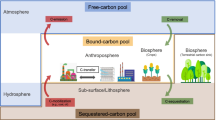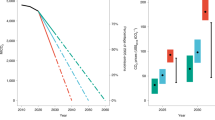Abstract
The social cost of carbon (SCC) is an estimate of the costs that society will incur because of the emission of one tonne of CO2. Because of the large uncertainties in the effects of climate change and the subjectivity of the discount rate, estimates of SCC range widely, from − 10.2 to 105 213$ t−1 in 2010 USD. Despite this range, the SCC has been used or proposed as a basis for a wide variety of policymaking including cost–benefit analysis and carbon taxes. The SCC suffers from several practical and philosophical weaknesses: it is anthropocentric, it neglects the acidification of oceans, it assumes that quantifiable economic variables like GDP are the primary costs that humans will experience from climate change, and it is impossible to quantify objectively. Further, the ethical implications of a carbon pricing policy include both the value of the carbon price, and the use of revenues generated by the policy. Thus, revenue neutral carbon policies as in some SCC-based proposals, are unlikely to be just. Here, we propose that the cost of emerging negative-emission technologies would be an alternative means for setting a carbon price and avoid these philosophical and practical weaknesses.





Similar content being viewed by others
Notes
Of course, if the answer is “no”, one must wonder why have a climate policy at all.
References
Ackerman, F., and E.A. Stanton. 2012. Climate risks and carbon prices: Revising the social cost of carbon. Economics 6: 1–25.
Anthoff, D., and R.S. Tol. 2013. The uncertainty about the social cost of carbon: A decomposition analysis using fund. Climatic Change 117: 515–530.
Archer, D., M. Eby, V. Brovkin, A. Ridgwell, L. Cao, U. Mikolajewicz, K. Caldeira, K. Matsumoto, et al. 2009. Atmospheric lifetime of fossil fuel carbon dioxide. Annual Review of Earth and Planetary Sciences 37: 117–134.
Batavia, C., and M.P. Nelson. 2017. For goodness sake! What is intrinsic value and why should we care? Biological Conservation 209: 366–376.
Beck, M., and T. Krueger. 2016. The epistemic, ethical, and political dimensions of uncertainty in integrated assessment modeling. Wiley Interdisciplinary Reviews: Climate Change 7: 627–645.
Beckerman, W., and C. Hepburn. 2007. Ethics of the discount rate in the Stern Review on the economics of climate change. World Economics 8: 187.
Bhave, A., R.H. Taylor, P. Fennell, W.R. Livingston, N. Shah, N. Mac Dowell, J. Dennis, M. Kraft, et al. 2017. Screening and techno-economic assessment of biomass-based power generation with CCS technologies to meet 2050 CO2 targets. Applied Energy 190: 481–489.
Burke, M.B., E. Miguel, S. Satyanath, J.A. Dykema, and D.B. Lobell. 2009. Warming increases the risk of civil war in Africa. Proceedings of the National Academy of Sciences 106: 20670–20674.
Cai, Y., T.M. Lenton, and T.S. Lontzek. 2016. Risk of multiple interacting tipping points should encourage rapid CO2 emission reduction. Nature Climate Change 6: 520.
Costanza, R., R. de Groot, P. Sutton, S. Van der Ploeg, S.J. Anderson, I. Kubiszewski, S. Farber, and R.K. Turner. 2014. Changes in the global value of ecosystem services. Global Environmental Change 26: 152–158.
Council of the European Communities. 1992. Treaty on European Union. Ed. E. Union. Luxemborg: Council of the European Communities.
Dai, A. 2013. Increasing drought under global warming in observations and models. Nature Climate Change 3: 52.
Dimson, E., P. Marsh, and M. Staunton. 2016. Long-term asset returns. In Financial market history, 2–26. Charlottesville: CFA Institute Research Foundation.
Drupp, M.A., M.C. Freeman, B. Groom, and F. Nesje. 2018. Discounting disentangled. American Economic Journal: Economic Policy 10: 109–134.
Eby, M., K. Zickfeld, A. Montenegro, D. Archer, K. Meissner, and A. Weaver. 2009. Lifetime of anthropogenic climate change: Millennial time scales of potential CO2 and surface temperature perturbations. Journal of Climate 22: 2501–2511.
Edmonds, J., P. Luckow, K. Calvin, M. Wise, J. Dooley, P. Kyle, S.H. Kim, P. Patel, et al. 2013. Can radiative forcing be limited to 2.6 Wm−2 without negative emissions from bioenergy and CO2 capture and storage? Climatic Change 118: 29–43.
Energy Information Administration. 2019. Levelized cost and levelized avoided cost of new generation resources in the annual energy outlook 2019. Washington, DC: Department of Energy.
Environmental Protection Agency. 2016. The social cost of carbon.
Fuss, S., W.F. Lamb, M.W. Callaghan, J. Hilaire, F. Creutzig, T. Amann, T. Beringer, W. de Oliveira Garcia, et al. 2018. Negative emissions—Part 2: Costs, potentials and side effects. Environmental Research Letters 13: 063002.
Gardiner, S.M. 2004. Ethics and global climate change. Ethics 114: 555–600.
Gasser, T., C. Guivarch, K. Tachiiri, C. Jones, and P. Ciais. 2015. Negative emissions physically needed to keep global warming below 2 C. Nature Communications 6: 7958.
Goeppert, A., M. Czaun, G.S. Prakash, and G.A. Olah. 2012. Air as the renewable carbon source of the future: an overview of CO2 capture from the atmosphere. Energy & Environmental Science 5: 7833–7853.
Hänsel, M.C., and M.F. Quaas. 2018. Intertemporal distribution, sufficiency, and the social cost of carbon. Ecological Economics 146: 520–535.
Hansen, J. 2010. Storms of my grandchildren: The truth about the coming climate catastrophe and our last chance to save humanity. New York: Bloomsbury Publishing.
Havranek, T., Z. Irsova, K. Janda, and D. Zilberman. 2015. Selective reporting and the social cost of carbon. Energy Economics 51: 394–406.
Herron, S., A. Zoelle, and W.M. Summers. 2014. Cost of capturing CO2from industrial sources. Pittsburgh: NETL.
IPCC. 2014. Climate change 2014: Synthesis report. Contribution of Working Groups I, II, and III to the fifth assessment report of the intergovernmental panel on climate change. IPCC, Geneva, Switzerland.
Jenkins, W., and C.K. Chapple. 2011. Religion and environment. Annual Review of Environment and Resources 36: 441–463.
Johnson, L.T., and C. Hope. 2012. The social cost of carbon in US regulatory impact analyses: An introduction and critique. Journal of Environmental Studies and Sciences 2: 205–221.
Kaiser, M.J., and B. Snyder. 2009. Supplemental bonding in the Gulf of Mexico: The potential effects of increasing bond requirements. International Journal of Oil, Gas and Coal Technology 2: 262–279.
Keith, D.W., G. Holmes, D.S. Angelo, and K. Heidel. 2018. A process for capturing CO2 from the atmosphere. Joule 2: 1573–1594.
Kelley, C.P., S. Mohtadi, M.A. Cane, R. Seager, and Y. Kushnir. 2015. Climate change in the fertile crescent and implications of the recent Syrian drought. Proceedings of the National Academy of Sciences 112: 3241–3246.
Kolstad, C., K. Urama, J. Broome, A. Bruvoll, M. Cariño-Olvera, D. Fullerton, C. Gollier, W.M. Hanemann, et al. 2014. Social, economic and ethical concepts and methods. In Climate change 2014: Mitigation of climate change. Contribution of Working Group III to the fifth assessment report of the intergovern-mental panel on climate change, ed. O. Edenhofer, R. Pichs-Madruga, Y. Sokona, E. Farahani, S. Kadner, K. Seyboth, A. Adler, I. Baum, et al. Cambridge: Cambridge University Press.
Lontzek, T.S., Y. Cai, K.L. Judd, and T.M. Lenton. 2015. Stochastic integrated assessment of climate tipping points indicates the need for strict climate policy. Nature Climate Change 5: 441.
Mathews, J.A. 2008. Carbon-negative biofuels. Energy Policy 36: 940–945.
McKinnon, C. 2015. Climate justice in a carbon budget. Climatic Change 133: 375–384.
Medlock, J.M., and S.A. Leach. 2015. Effect of climate change on vector-borne disease risk in the UK. The Lancet Infectious Diseases 15: 721–730.
Metcalf, G.E. 2009. Designing a carbon tax to reduce US greenhouse gas emissions. Review of Environmental Economics and Policy 3: 63–83.
Metcalf, G.E., and J.H. Stock. 2017. Integrated assessment models and the social cost of carbon: A review and assessment of US experience. Review of Environmental Economics and Policy 11: 80–99.
Moore, F.C., and D.B. Diaz. 2015. Temperature impacts on economic growth warrant stringent mitigation policy. Nature Climate Change 5: 127.
Morrison, T.H., T.P. Hughes, W.N. Adger, K. Brown, J. Barnett, and M.C. Lemos. 2019. Save reefs to rescue all ecosystems. Nature 573: 333–336.
Mueller, V., C. Gray, and K. Kosec. 2014. Heat stress increases long-term human migration in rural Pakistan. Nature Climate Change 4: 182.
Narita, D., and K. Rehdanz. 2017. Economic impact of ocean acidification on shellfish production in Europe. Journal of Environmental Planning and Management 60: 500–518.
Narita, D., K. Rehdanz, and R.S. Tol. 2012. Economic costs of ocean acidification: A look into the impacts on global shellfish production. Climatic Change 113: 1049–1063.
National Research Council and Committee on Population. 2000. Beyond six billion: Forecasting the world’s population. Washington, DC: National Academies Press.
Neumayer, E. 2000. In defence of historical accountability for greenhouse gas emissions. Ecological Economics 33: 185–192.
Nordhaus, W. 2007. Critical assumptions in the Stern review on climate change. Science 317: 201–202.
Nordhaus, W. 2014. Estimates of the social cost of carbon: Concepts and results from the DICE-2013R model and alternative approaches. Journal of the Association of Environmental and Resource Economists 1: 273–312.
Nordhaus, W.D. 2017. Revisiting the social cost of carbon. Proceedings of the National Academy of Sciences 114: 1518–1523.
OECD. 1972. Recommendation of the Council on guiding principles concerning international economic aspects of environmental policies. OECD.
Pezzey, J.C. 2018. High unknowability of climate damage valuation means the social cost of carbon will always be disputed. Centre for Climate Economics & Policy, Crawford School of Public Policy, The Australian National University.
Pezzey, J.C. 2019. Why the social cost of carbon will always be disputed. Wiley Interdisciplinary Reviews: Climate Change 10: e558.
Pindyck, R.S. 2019. The social cost of carbon revisited. Journal of Environmental Economics and Management 94: 140–160.
Pizer, W., M. Adler, J. Aldy, D. Anthoff, M. Cropper, K. Gillingham, M. Greenstone, B. Murray, et al. 2014. Using and improving the social cost of carbon. Science 346: 1189–1190.
Smith, P., S.J. Davis, F. Creutzig, S. Fuss, J. Minx, B. Gabrielle, E. Kato, R.B. Jackson, et al. 2016. Biophysical and economic limits to negative CO2 emissions. Nature Climate Change 6: 42.
Stern, N., and C. Taylor. 2007. Climate change: Risk, ethics, and the Stern review. Science 317: 203–204.
Tol, R.S. 2018. The impact of climate change and the social cost of carbon. Working paper series 1318, Department of Economics, University of Sussex Business School.
van den Bergh, J.C., and W. Botzen. 2015. Monetary valuation of the social cost of CO2 emissions: a critical survey. Ecological Economics 114: 33–46.
Van Den Bergh, J.C., and W.J. Botzen. 2014. A lower bound to the social cost of CO2 emissions. Nature Climate Change 4: 253.
Zhang, D.D., H.F. Lee, C. Wang, B. Li, Q. Pei, J. Zhang, and Y. An. 2011. The causality analysis of climate change and large-scale human crisis. Proceedings of the National Academy of Sciences 108: 17296–17301.
Acknowledgements
The author thanks two anonymous reviewers for their excellent feedback on the manuscript.
Author information
Authors and Affiliations
Corresponding author
Additional information
Publisher's Note
Springer Nature remains neutral with regard to jurisdictional claims in published maps and institutional affiliations.
Rights and permissions
About this article
Cite this article
Snyder, B.F. Beyond the social cost of carbon: Negative emission technologies as a means for biophysically setting the price of carbon. Ambio 49, 1567–1580 (2020). https://doi.org/10.1007/s13280-019-01301-y
Received:
Revised:
Accepted:
Published:
Issue Date:
DOI: https://doi.org/10.1007/s13280-019-01301-y




